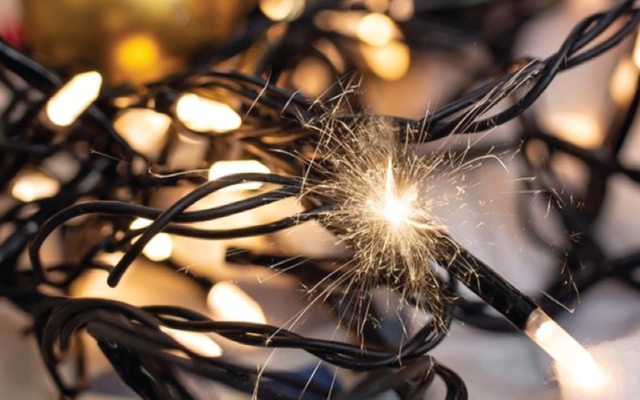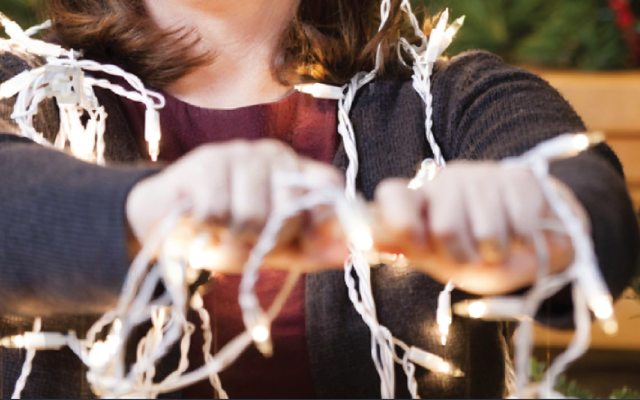
Power & Christmas Lights

What They Use & How to Manage Them
With holiday season around the corner, twinkling lights are starting to appear on houses, city streets, and store windows across the country. Festive illumination has a way of warming and charming the darkest, dreariest months of the year. But what may not be so immediately charming is their power bill.
From a couple strands of lights on a tree to an extravagant outdoor extravaganza, every electrifying decoration uses energy. How Christmas lights use power, how much they use, and how to manage that usage matters for your budget, safety, and even environmental footprint. Let’s take a closer look at the sparkling world of Christmas lights.

Christmas Lights & Power Requirements
Christmas lights come in all shapes, sizes, and technological varieties, each with their own electricity appetite. The most common types of lights are incandescent and LED.
Incandescent Christmas Lights:
Incandescent lights are the classic bulbs that have been stringing holiday cheer for generations. These bulbs produce light by passing electricity through a metal filament until it gets hot enough to glow. As you might imagine, this method also generates a lot of heat and uses more energy.
- Power consumption: 40 to 60 watts per 100-bulb string
- Lifetime: Approximately 1,000 hours
- Heat output: High (can be a fire hazard if left on too long or if they come in contact with flammable materials)
- Cost: Lower initial cost, but more expensive over the long term due to higher power use and replacement needs
LED Christmas Lights:
Light Emitting Diode (LED) lights have rapidly become the most energy-efficient lighting option. They emit light through a semiconductor, using a tiny fraction of the power and creating very little heat.
- Power consumption: 5 to 10 watts per 100-bulb string
- Lifetime: 25,000 to 50,000 hours
- Heat output: Very low (safe to use for long periods and when in contact with other materials)
- Cost: Higher initial cost, but much less expensive for electricity and with a much longer lifespan
Example Comparison:
Say you are decorating a 6-foot Christmas tree:
- With incandescent lights (400 total bulbs): \~240 watts total power use
- With LED lights (400 total bulbs): \~24 watts total power use
Multiplied over several hours per day for a month, the difference is huge—in both power consumption and cost on your utility bill.
How Much Electricity Do Christmas Lights Use?
How much energy your Christmas lights use really depends on:
- Number of bulbs or strings
- Wattage per bulb or string
- Hours they are on each day
- Length of the display period (days vs. weeks vs. months)
Here is a breakdown of actual energy use and cost, using some common examples:

Switching from incandescent to LED lights can cut your Christmas lighting power bill by 80–90%!
Power Safety Tips for Holiday Light Displays
Beauty and festivity are all well and good, but **safety** should always come first. Planning a Christmas light display without paying attention to power limits can easily overload a circuit, blowing fuses, damaging outlets and electronics, or causing a fire hazard.
Circuit Power Capacity:
The electrical outlets in your home are normally connected to either 15-amp or 20-amp circuits. Adding too many high-wattage lights to a single outlet can trip a breaker or lead to dangerous heat build-up.
- 15-amp circuit: max of 1,800 watts (it is safe to use up to 1,400W to leave some margin)
- 20-amp circuit: max of 2,400 watts (use up to \~1,900W safely)
If you are using incandescent lights, it is easy to go over this limit. A few strings plugged into one outlet can consume several hundred watts by themselves.
Safe Connection Limits:
- Incandescent lights: connect a maximum of 3 to 5 strings together in series
- LED lights: can connect 20 to 40 strings (depending on the brand and wattage)

Power Saving Tips & Tricks
You don’t need to go all-out to have a memorable display this holiday season. Check out a few ideas for conserving energy while still spreading some Christmas cheer:
Energy-Saving Ideas:
- Use timers: set lights to automatically turn on at dusk and off before bed (e.g. 5:00 p.m. to 10:00 p.m.)
- Go solar: solar-powered lights are great for smaller outdoor areas such as trees, fences, or walkways
- Use reflective decorations: tinsel, mirrored ornaments, and metallic finishes all enhance light effect without requiring more bulbs
- Decorate high-impact areas: instead of lighting up the whole house, decorate the front door, windows, or a single focal tree
Environment Impact of Holiday Lighting
Holiday lighting in the US contributes to a visible spike in national electricity consumption every December. A study by the Department of Energy found that if every household replaced their incandescent holiday lights with LEDs, the country could save **billions of kilowatt-hours per year**—enough to power hundreds of thousands of homes for a month.
Making the switch to LEDs and using smart timers is not just better for your wallet—it’s also better for the environment.

Shine Bright, But Shine Smart
Lights are an important part of the Christmas magic, bringing joy, nostalgia, and beauty to the holiday season. But along with that comes a responsibility to use power wisely. Whether you’re stringing up a few strands on a tree or taking over the whole neighborhood, being energy conscious and safety aware helps make sure your holidays are brighter (and safer).
As you get ready to deck the halls this holiday season, let your lights do more than just reflect holiday cheer. Make your displays shine with intention, too. Choose the right types of lights, power them wisely, and use them for the right amount of time, and you can make your holiday decorations beautiful, festive, and efficient. You can dazzle and entertain, but you can do it without breaking the bank or stressing the grid. With a little planning and some smart tech, your holiday display can be as dazzling as it is efficient. By understanding and managing the power behind your holiday lights, you can enjoy a season that’s merry, bright, and responsibly lit.



